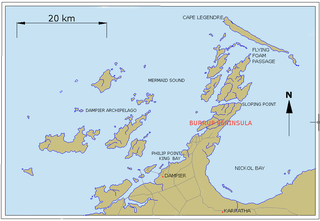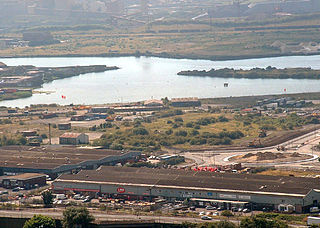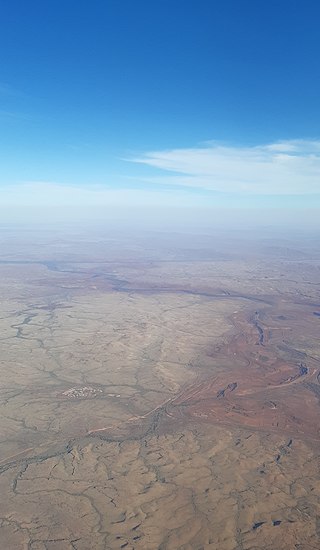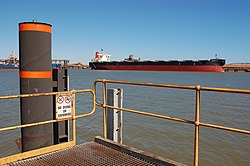
Dampier is a major industrial port in the Pilbara region in the northwest of Western Australia. It is located near the city of Karratha and Port Walcott.
The Pilbara is a large, dry, thinly populated region in the north of Western Australia. It is known for its Aboriginal peoples; its ancient landscapes; the red earth; and its vast mineral deposits, in particular iron ore. It is also a global biodiversity hotspot for subterranean fauna.

Port Hedland is the second largest town in the Pilbara region of Western Australia, with an urban population of 15,298 as of the 2021 census, including the satellite town of South Hedland, 18 kilometres (11 mi) away. It is also the site of the highest tonnage port in Australia.

The Port of Port Talbot is located on the River Afan estuary next to Port Talbot Steelworks in the industrial town of Port Talbot, South Wales. The whole basin complex covers about 500 acres (2.0 km2), consisting of: an inner set of floating docks, developed from 1834 onwards; and an outer tidal basin, completed in 1970. Owned and operated by Associated British Ports, the tidal basin has the deepest berthing facilities in the Severn estuary and is one of only a few harbours in the UK capable of handling Capesize vessels of up to 170,000 tonnes deadweight (DWT), mostly for the import of iron ore and coal for use by nearby Port Talbot Steelworks.

The Port of Albany is located within Princess Royal Harbour in King George Sound on the south coast of Western Australia, in the Great Southern region.

The Hamersley & Robe River railway, majority-owned by Rio Tinto, and operated by its subsidiary Pilbara Iron, is a private rail network in the Pilbara region of Western Australia for the purpose of carrying iron ore. The network is larger than any other Australian heavy freight rail network in private ownership. The total length of its track is about 1,700 km (1,056 mi).

The Goldsworthy railway, owned and operated by BHP, is a private rail network in the Pilbara region of Western Australia built to carry iron ore. It is one of two railway lines BHP operates in the Pilbara, the other being the Mount Newman railway.
Cape Lambert is a port facility operated by Rio Tinto Iron Ore in the Pilbara region of Western Australia. It is located 40 kilometres north-east of Karratha.

The Mount Whaleback mine, officially the Newman West operation, is an iron ore mine located in the Pilbara region of Western Australia, six kilometres west of Newman.

Iron ore mining in Western Australia, in the 2018–19 financial year, accounted for 54 percent of the total value of the state's resource production, with a value of A$78.2 billion. The overall value of the minerals and petroleum industry in Western Australia was A$145 billion in 2018–19, a 26 percent increase on the previous financial year.
The Area C mine is an iron ore mine located in the Pilbara region of Western Australia, 92 kilometres west-north-west of Newman.
The Jimblebar mine is an iron ore mine located in the Pilbara region of Western Australia, 41 kilometres east of Newman.
The Yarrie mine is an iron ore mine located in the Pilbara region of Western Australia, 90 kilometres north-east of Marble Bar.

The Yandi mine is an iron ore mine located in the Pilbara region of Western Australia, 90 kilometres north-west of Newman. It should not be confused with Rio Tinto's nearby Yandicoogina mine, which is also sometimes shortened to Yandi.
The Orebodies 18, 23 and 25 mine, part of BHP's Eastern Ridge hub and officially referred to as the Newman East operation, is an iron ore mine located in the Pilbara region of Western Australia, 8 kilometres east of Newman. The mine is majority-owned and operated by BHP, and is one of seven iron ore mines the company operates in the Pilbara. The company also operates two port facilities at Port Hedland, Nelson Point and Finucane Island, and over 1,000 kilometres of rail in the Pilbara.
The Roy Hill mine is an iron ore mine in the Chichester Range in the Pilbara region of Western Australia, located 115 kilometres (71 mi) north of Newman and 277 kilometres (172 mi) south of Port Hedland. With indicated and inferred reserves of more than 2.4 billion tonnes, it is expected to become one of the largest mining projects in Australia. Mining operations will produce 55 million tonnes of iron ore per annum with an operating life of more than 20 years.
Port Walcott, formerly known as Tien Tsin Harbour, is a large open water harbour located on the northwest coast of Western Australia, located near the town of Point Samson.
The Railways in the Pilbara are a collection of railways in the Pilbara region of north-west Western Australia.

The Pilbara Coast is the coastline of Western Australia's Pilbara region. It is often referred to as the North West Coast of Western Australia.
East Intercourse Island is an uninhabited island in the Dampier Archipelago, in the Pilbara, Western Australia. It is around 250 hectares in size.















